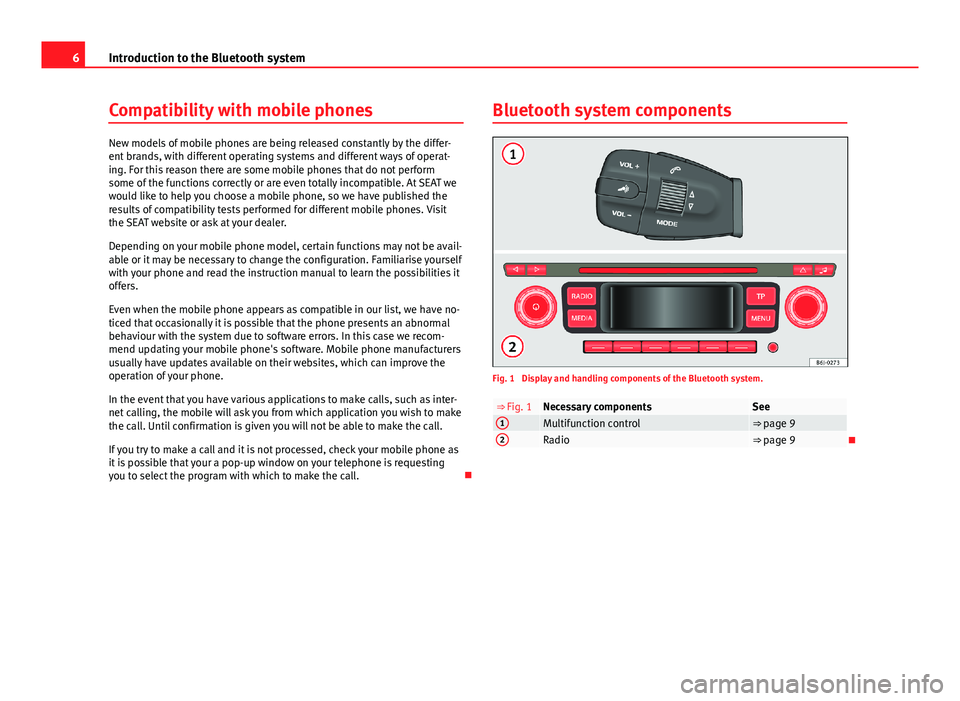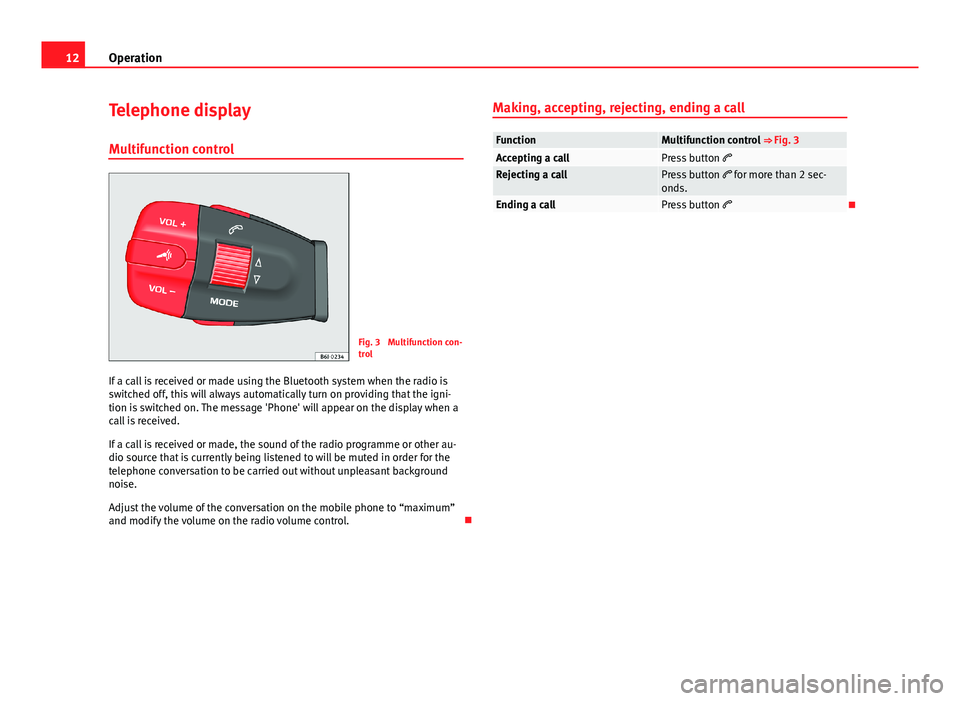radio Seat Toledo 2012 BLUETOOTH SYSTEM
[x] Cancel search | Manufacturer: SEAT, Model Year: 2012, Model line: Toledo, Model: Seat Toledo 2012Pages: 17, PDF Size: 0.54 MB
Page 7 of 17

6Introduction to the Bluetooth systemCompatibility with mobile phones
New models of mobile phones are being released constantly by the differ-ent brands, with different operating systems and different ways of operat-ing. For this reason there are some mobile phones that do not performsome of the functions correctly or are even totally incompatible. At SEAT wewould like to help you choose a mobile phone, so we have published theresults of compatibility tests performed for different mobile phones. Visitthe SEAT website or ask at your dealer.
Depending on your mobile phone model, certain functions may not be avail-able or it may be necessary to change the configuration. Familiarise yourselfwith your phone and read the instruction manual to learn the possibilities itoffers.
Even when the mobile phone appears as compatible in our list, we have no-ticed that occasionally it is possible that the phone presents an abnormalbehaviour with the system due to software errors. In this case we recom-mend updating your mobile phone's software. Mobile phone manufacturersusually have updates available on their websites, which can improve theoperation of your phone.
In the event that you have various applications to make calls, such as inter-net calling, the mobile will ask you from which application you wish to makethe call. Until confirmation is given you will not be able to make the call.
If you try to make a call and it is not processed, check your mobile phone asit is possible that your a pop-up window on your telephone is requestingyou to select the program with which to make the call.
Bluetooth system componentsFig. 1
Display and handling components of the Bluetooth system.
⇒ Fig. 1Necessary componentsSee1Multifunction control⇒ page 92Radio⇒ page 9
Page 11 of 17

10OperationBasic functions available with the voice controls
Volume adjustment
You can change the sound volume at any time with the radio button or withthe buttons on the multifunction control.
The volume transmitted by the speaker depends, among other aspects, onthe volume transmitted by the mobile. If the volume of the mobile is low, oron silent, it is possible that no sound will be heard through the car speaker.
Adjust the volume of your Bluetooth device to the maximum.
Do not leave headphones connected to the Bluetooth device when you wishto use the hands free system.
Complying with these requirements, if the speaker volume is very high, ad-just it using the controls on the steering wheel or the volume control on theradio.
Voice control connection (Dialogue)
You can start the dialogue at any time by briefly pressing the PTT button on the multifunction control.
If the system does not recognise your command, there is a first help optionwhich allows a new input. After a second failed try the system repeats thesecond part of the help. After a third failure the system will answer with“Operation cancelled” and the dialogue will be ended.
Disconnection of the voice control (Dialogue)
You can end the dialogue at any time by briefly pressing the PTT button on the multifunction control. If the system is waiting for a command, youcan end the dialogue with the “CANCEL” command.
Interruption of the current message
By pressing the PTT button during the message, only the current mes-sage is ended and it is possible to give another command.
Correct use of the voice control
Note the following to ensure that you are properly understood:
●
Speak in a normal tone and without pauses or exaggerated pronuncia-tion.
●
Avoid poor articulation of words.
●
Keep the doors, windows and sun roof closed if possible to avoid back-ground noises that might affect the system.
●
Keep the air vents directed away from the microphone (located on theinterior light).
●
At high speeds, you might need to speak louder to drown out back-ground noises.
●
Avoid other noises in the vehicle during a dialogue (e.g. other passen-gers speaking in the vehicle).
●
Avoid speaking when the system is saying a cue.
●
The hands-free microphone is directed towards the driver, therefore, on-ly the driver should try to operate the system.
●
To make a call when there is heavy background noise we recommend us-ing the speech controlled telephone book instead of speaking individualdigits. This will help avoid mistakes when specifying telephone numbers.
Voice control orders (commands)
The voice control can be used in the following languages:
Spanish, Mexican Spanish, German, English, US English, French, CanadianFrench, Italian, Portuguese, Czech, Russian and Dutch.
Basic commands valid in any part of the menu
HELPAfter this command the system repeats all the possible com-mandsCANCELThe dialogue ends
Page 13 of 17

12OperationTelephone display
Multifunction control
Fig. 3
Multifunction con-trol
If a call is received or made using the Bluetooth system when the radio isswitched off, this will always automatically turn on providing that the igni-tion is switched on. The message 'Phone' will appear on the display when acall is received.
If a call is received or made, the sound of the radio programme or other au-dio source that is currently being listened to will be muted in order for thetelephone conversation to be carried out without unpleasant backgroundnoise.
Adjust the volume of the conversation on the mobile phone to “maximum”and modify the volume on the radio volume control.
Making, accepting, rejecting, ending a callFunctionMultifunction control ⇒ Fig. 3Accepting a callPress button Rejecting a callPress button for more than 2 sec-onds.Ending a callPress button
Page 14 of 17

IndexA
Adjust the volume . . . . . . . . . . . . . . . . . . . . . . . 10
Automatic pairing . . . . . . . . . . . . . . . . . . . . . . . . . 8
B
BluetoothAutomatic pairing . . . . . . . . . . . . . . . . . . . . . . 8Create user profile . . . . . . . . . . . . . . . . . . . . . 7General information . . . . . . . . . . . . . . . . . . . . 4Pairing the mobile phone . . . . . . . . . . . . . . . 7Visibility . . . . . . . . . . . . . . . . . . . . . . . . . . . . . 8
C
CallAccepting . . . . . . . . . . . . . . . . . . . . . . . . . . . 12Ending . . . . . . . . . . . . . . . . . . . . . . . . . . . . . . 12Making . . . . . . . . . . . . . . . . . . . . . . . . . . . . . 12Rejecting . . . . . . . . . . . . . . . . . . . . . . . . . . . . 12
Call list . . . . . . . . . . . . . . . . . . . . . . . . . . . . . . . . 11
Commands . . . . . . . . . . . . . . . . . . . . . . . . . . . . . 10
Compatibility with mobile phones . . . . . . . . . . . 6
Creation of user profile . . . . . . . . . . . . . . . . . . . . 7
D
Dialogue
Options . . . . . . . . . . . . . . . . . . . . . . . . . . . . . 11Push To Talk . . . . . . . . . . . . . . . . . . . . . . . . . . 9
F
Factory defaults . . . . . . . . . . . . . . . . . . . . . . . . . 11
G
General information . . . . . . . . . . . . . . . . . . . . . . . 4
Getting started . . . . . . . . . . . . . . . . . . . . . . . . . . . 7
I
Important information . . . . . . . . . . . . . . . . . . . . . 3
Introduction . . . . . . . . . . . . . . . . . . . . . . . . . . . . . 4
L
Languages . . . . . . . . . . . . . . . . . . . . . . . . . . 10, 11
M
Multifunction control . . . . . . . . . . . . . . . . . . . . 6, 9
O
Operation
Via controls . . . . . . . . . . . . . . . . . . . . . . . . . . . 9Via voice control . . . . . . . . . . . . . . . . . . . . . . . 9
P
Pairing the mobile phone . . . . . . . . . . . . . . . . . . 7
Phone book . . . . . . . . . . . . . . . . . . . . . . . . . . . . 11
Push To Talk (PTT) . . . . . . . . . . . . . . . . . . . . . . . . . 9End dialogue . . . . . . . . . . . . . . . . . . . . . . . . 10Interrupt dialogue . . . . . . . . . . . . . . . . . . . . 10
R
Radio . . . . . . . . . . . . . . . . . . . . . . . . . . . . . . . . . . 12
S
Safety warnings . . . . . . . . . . . . . . . . . . . . . . . . . . 5
SettingsCall history . . . . . . . . . . . . . . . . . . . . . . . . . . 11Phone book . . . . . . . . . . . . . . . . . . . . . . . . . 11
System components . . . . . . . . . . . . . . . . . . . . . . 6
T
Traffic safety . . . . . . . . . . . . . . . . . . . . . . . . . . . . . 3
13Index